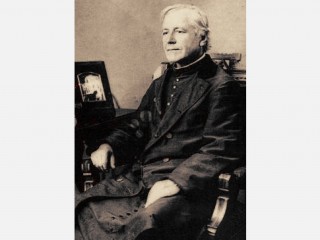
Albert Lacombe biography
Date of birth : 1827-02-28
Date of death : 1916-12-12
Birthplace : Saint-Sulpice, Quebec, Canada
Nationality : Canadian
Category : Famous Figures
Last modified : 2010-11-13
Credited as : Missionary priest, supporter of Indians ,
Albert Lacombe was a Canadian missionary priest and one of the great figures of the early Canadian West. A supporter of the Indians and Matis, he founded schools, churches, and industrial institutions.
Albert Lacombe was born in Saint-Sulpice, Quebec, on Feb. 28, 1827, and educated at L'Assomption College. In 1849 he was ordained into the priesthood and joined the Oblate order as a missionary priest. His field was to be the Canadian West, and Lacombe was quickly on the way. His first year was spent at Pembina, a rough forest mission that served the Matis, a half-breed population of Assiniboia, and here he experienced all the hardships and glories of the country: the buffalo hunt, the seriocomic raids of pillaging Indians, the rough life of the time.
After a brief visit to Montreal in 1850 Lacombe was soon on his way west once again, this time to Ft. Edmonton, the headquarters of the Hudson's Bay Company in the Far West. With Edmonton as his base, the priest was soon roaming the whole West, visiting the Peace River country, trying patiently to convert the Blackfeet Indians, founding colonies for the Matis. The man's energy was phenomenal, and Lacombe was clearly an organizational genius. At his colony of Saint-Albert he built the first bridge west of the Red River, a minor marvel of engineering that became known to the Matis as "The Bridge." Similarly he organized cart trains to move goods from the Red River westward in an effort to defeat the company's monopoly and consequent high rates. And everywhere he encouraged his people to break the plains to the plow and plant wheat. For years this life of toil continued for Lacombe. There were triumphs as Indian tribes were converted and pacified; there were disasters when smallpox ravaged whole settlements.
Lacombe did not return east until 1872, and after visits to Europe he came back to become the parish priest of St. Mary's in Winnipeg and was intimately involved in the lingering aftermath of the first Riel rebellion. By 1880, as the Canadian Pacific Railway (CPR) began to cross the plains, Lacombe was on the move again, this time as chaplain to the CPR's rough construction camps, and by 1884 he was in Calgary, once again founding industrial schools.
There was more excitement soon, for the second Riel rebellion burst on the West in 1884 and 1885. Lacombe was instrumental in persuading the Blackfeet not to join in the revolt, and soon after he was in Ottawa trying to persuade the government to grant amnesty to the Cree and Matis who had joined the rebel Louis Riel. By 1890 he was involved in the question of schools in Manitoba, and the old priest found himself deeply involved in partisan politics for the first time. For the rest of his life he was in a working retirement, and he remained active and alert until his death at Midnapore, Alberta, on Dec. 12, 1916. Sometimes called the "Black-robe Voyageur," he had been instrumental in the opening of the West.
A biography of Lacombe is by Katherine Hughes, Father Lacombe, the Black-robe Voyageur (1911). Some information on his life is in George Francis Stanley, The Birth of Western Canada (1960). See also R. G. MacBeth, The Romance of Western Canada (1918).
















